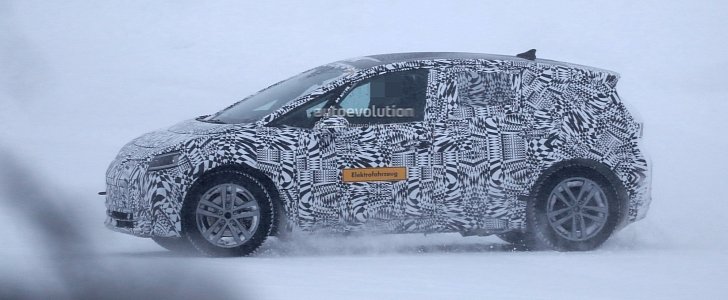Believed to go official as the ID. Neo, the compact-sized electric hatchback that Volkswagen refers to as ID. is getting closer to production reality. The assembly line in Zwickau, Germany will start churning EVs in November 2019, but until then, the engineers are busy cold-weather testing.
Spied close to the Arctic Circle, the ID. prototype in the following photographs is just as camouflaged as the vehicles that Volkswagen tested a few months back in South Africa. Large windows, sufficient ground clearance, double-spoke wheels with five lug nuts, and a flat underfloor are featured.
Elektrofahrzeug written in black over orange means “electric vehicle,” which is nice of Volkswagen to mention on both sides of the ID. prototype. Sequential LED turn signals are also visible, complemented by turn signals integrated into the mirror caps.
The few shots where the interior can be seen through the driver-side window don’t reveal much of the dashboard, but then again, what could Volkswagen have in the pipeline? A digital instrument cluster and large-diameter touchscreen infotainment are obvious elements.
As far as the powertrain is concerned, the rear wheels are driven by an e-motor rated at 150 kW. Make that 204 PS or 201 horsepower. The entry-level battery is WLTP-rated 330 kilometers (205 miles) according to Frank Bekemeier, chief technology officer in charge of the e-Mobility product line.
Range can be extended to more than 500 kilometers (311 miles) with the largest battery, but not much is know about capacity in kilowatt-hours. Customers will be offered an option to charge at up to 125 kW. By comparison, the Tesla Model 3 was clocked at 126 kW in the Netherlands, connected to a 175-kW Fastned charging station.
It’s understood the cheapest ID. in the lineup will be priced similarly to a diesel-engined Golf. This ambiguous statement can be interpreted in plenty of ways, but for reference, remember that the Golf Trendline starts at €19,300 for the 1.0 TSI OPF while the 1.6 TDI SCR costs €23,875.
Although subcompact rather than compact hatchback like the ID., the Opel Ampera-e and Hyundai Kona Elektro retail at €42,990 and €34,600. If we look at the bigger picture for a few seconds, the ID. is more likely to cost €24,000 with the €4,000 incentive for electric vehicles from the German government rather than without it.
Elektrofahrzeug written in black over orange means “electric vehicle,” which is nice of Volkswagen to mention on both sides of the ID. prototype. Sequential LED turn signals are also visible, complemented by turn signals integrated into the mirror caps.
The few shots where the interior can be seen through the driver-side window don’t reveal much of the dashboard, but then again, what could Volkswagen have in the pipeline? A digital instrument cluster and large-diameter touchscreen infotainment are obvious elements.
As far as the powertrain is concerned, the rear wheels are driven by an e-motor rated at 150 kW. Make that 204 PS or 201 horsepower. The entry-level battery is WLTP-rated 330 kilometers (205 miles) according to Frank Bekemeier, chief technology officer in charge of the e-Mobility product line.
Range can be extended to more than 500 kilometers (311 miles) with the largest battery, but not much is know about capacity in kilowatt-hours. Customers will be offered an option to charge at up to 125 kW. By comparison, the Tesla Model 3 was clocked at 126 kW in the Netherlands, connected to a 175-kW Fastned charging station.
It’s understood the cheapest ID. in the lineup will be priced similarly to a diesel-engined Golf. This ambiguous statement can be interpreted in plenty of ways, but for reference, remember that the Golf Trendline starts at €19,300 for the 1.0 TSI OPF while the 1.6 TDI SCR costs €23,875.
Although subcompact rather than compact hatchback like the ID., the Opel Ampera-e and Hyundai Kona Elektro retail at €42,990 and €34,600. If we look at the bigger picture for a few seconds, the ID. is more likely to cost €24,000 with the €4,000 incentive for electric vehicles from the German government rather than without it.






















